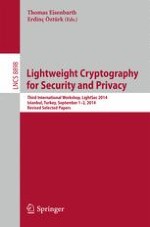2015 | Buch
Lightweight Cryptography for Security and Privacy
Third International Workshop, LightSec 2014, Istanbul, Turkey, September 1-2, 2014, Revised Selected Papers
herausgegeben von: Thomas Eisenbarth, Erdinç Öztürk
Verlag: Springer International Publishing
Buchreihe : Lecture Notes in Computer Science
